NSC COP87L88RKV-XE, COP87L88RKN-XE, COP87L88EKV-XE, COP87L88EKN-XE, COP87L84RKN-XE Datasheet
...
September 1999
COP87L88EK/RK Family
8-Bit CMOS OTP Microcontrollers with 8k or 32k Memory, Comparator, and Single-slope A/D Capability
General Description
The COP87L88EK/RK Family OTP (One Time Programmable) microcontrollers are highly integrated COP8™ Feature core devices with 16k or 32k memory and advanced features including a Multi-Input Comparator and Single-slope A/D capability. These multi-chip CMOS devices are suited for applications requiring a full featured, low EMI controller with an analog comparator, current source, and voltage reference, and as pre-production devices for a masked ROM design. Lower cost pin and software compatible 8k ROM versions (COP888EK) are available for use with a range of COP8 software and hardware development tools.
Family features include an 8-bit memory mapped architecture, 10 MHz CKI (-XE = crystal oscillator) with 1 µs instruction cycle, three multi-function 16-bit timer/counters with PWM, MICROWIRE/PLUS™ serial I/O, one analog comparator with seven input multiplexor, an analog current source and VCC/2 reference, two power saving HALT/IDLE modes, idle timer, MIWU, high current outputs, software selectable I/O options, WATCHDOG™ timer and Clock Monitor, 2.7V to 5.5V operation and 28/40/44 pin packages.
Devices included in this datasheet are:
Device |
Memory (bytes) |
RAM (bytes) |
I/O Pins |
|
Packages |
Temperature |
|
|
|
|
|
|
|
COP87L84EK |
16k OTP EPROM |
256 |
24 |
28 |
DIP/SOIC |
-40 to +85ÊC |
COP87L88EK |
16k OTP EPROM |
256 |
36/40 |
40 |
DIP, 44 PLCC |
-40 to +85ÊC |
COP87L84RK |
32k OTP EPROM |
256 |
24 |
28 |
DIP/SOIC |
-40 to +85ÊC |
COP87L88RK |
32k OTP EPROM |
256 |
36/40 |
40 |
DIP, 44 PLCC |
-40 to +85ÊC |
|
|
|
|
|
|
|
Key Features
nAnalog function block with
ÐAnalog comparator with seven input multiplexor
ÐConstant current source and V CC/2 reference
nThree 16-bit timers, each with two 16-bit registers supporting:
ÐProcessor Independent PWM mode
ÐExternal Event counter mode
ÐInput Capture mode
n8 or 32 kbytes on-board EPROM with security feature
n256 bytes on-board RAM
Additional Peripheral Features
nIdle Timer
nMulti-Input Wake Up (MIWU) with optional interrupts (8)
nWATCHDOG and Clock Monitor logic
nMICROWIRE/PLUS serial I/O
I/O Features
nSoftware selectable I/O options ( TRI-STATE™ Output, Push-Pull Output, Weak Pull-Up Input, High Impedance Input)
nPackages:
Ð44 PLCC with 40 I/O pins
Ð40 DIP with 36 I/O pins
Ð28 DIP/SO with 24 I/O pins
n Schmitt trigger inputs on Port G and L
CPU/Instruction Set Feature
n1 µs instruction cycle time
nTwelve multi-source vectored interrupts servicing
ÐExternal Interrupt with selectable edge
ÐIdle Timer T0
ÐThree Timers (Each with 2 interrupts)
ÐMICROWIRE/PLUS
ÐMulti-Input Wake Up
ÐSoftware Trap
ÐDefault VIS (default interrupt)
nVersatile and easy to use instruction set
n8-bit Stack Pointer (SP) Ð stack in RAM
nTwo 8-bit Register Indirect Data Memory Pointers (B, X)
Fully Static CMOS
nTwo power saving modes: HALT and IDLE
nSingle supply operation: 2.7V to 5.5V
nTemperature ranges: −40ÊC to +85ÊC
Development Support
nEmulation devices for the COP888EK/COP884EK
nReal time emulation and full program debug offered by MetaLink Development System
COP8™ is a trademark of National Semiconductor Corporation.
is a trademark of National Semiconductor Corporation. TRI-STATE® is a registered trademark of National Semiconductor Corporation.
is a trademark of National Semiconductor Corporation. is a trademark of MetaLink Corporation.
slope-Single and |
COP87L88EK/RK |
Capability A/D |
CMOS Bit-8 Family, |
|
Comparator, Memory, 32k or 8k with Microcontrollers OTP |
© 1999 National Semiconductor Corporation |
DS101133 |
www.national.com |
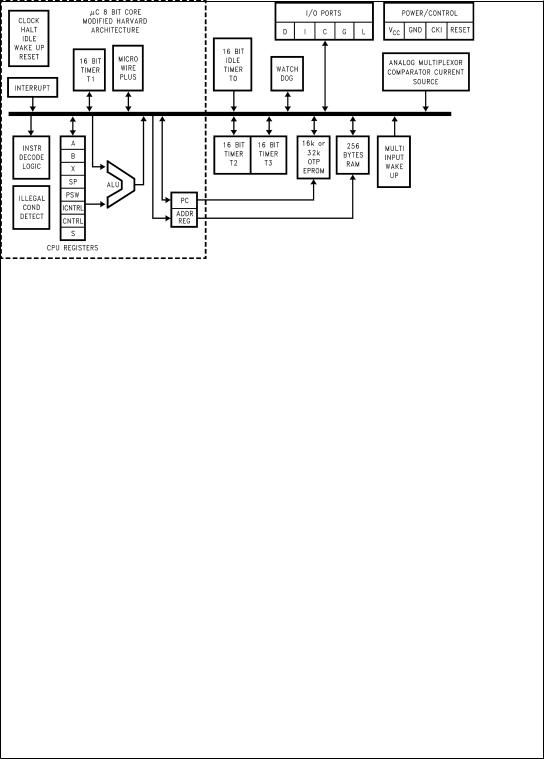
Block Diagram
DS101133-1
FIGURE 1. Block Diagram
www.national.com |
2 |
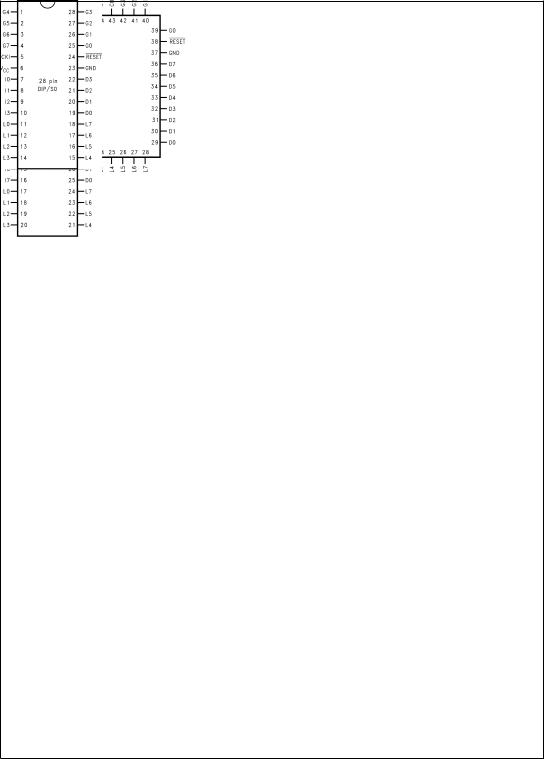
Connection Diagrams
Plastic Chip Carrier |
Dual-In-Line Package |
|
DS101133-2
Top View
Order Number COP87L88EKV-XE or COP87L88RKV-XE
See NS Plastic Chip Package Number V44A
DS101133-3
Top View
Order Number COP87L84EKN-XE or COP87L84RKN-XE
See NS Molded Package Number N40A
Dual-In-Line Package
DS101133-4
Top View
Order Number COP87L84EKN-XE or COP87L84RKN-XE
See NS Molded Package Number N28B
Order Number COP87L84EKM-XE or COP87L84RKM-XE
See NS Molded Package Number M28B
Note: -X Crystal Oscillator
-E Halt Mode Enabled
FIGURE 2. Connection Diagrams
3 |
www.national.com |

Connection Diagrams (Continued)
Pinouts for 28-, 40-, and 44-Pin Packages
|
Port |
Type |
Alt. Fun |
Alt. Fun |
28-Pin |
40-Pin |
44-Pin |
|
|
Pack. |
Pack. |
Pack. |
|||||
|
|
|
|
|
|
|||
|
L0 |
I/O |
MIWU |
|
11 |
17 |
17 |
|
|
L1 |
I/O |
MIWU |
|
12 |
18 |
18 |
|
|
L2 |
I/O |
MIWU |
|
13 |
19 |
19 |
|
|
L3 |
I/O |
MIWU |
|
14 |
20 |
20 |
|
|
L4 |
I/O |
MIWU |
T2A |
15 |
21 |
25 |
|
|
L5 |
I/O |
MIWU |
T2B |
16 |
22 |
26 |
|
|
L6 |
I/O |
MIWU |
T3A |
17 |
23 |
27 |
|
|
L7 |
I/O |
MIWU |
T3B |
18 |
24 |
28 |
|
|
|
|
|
|
|
|
|
|
|
G0 |
I/O |
INT |
|
25 |
35 |
39 |
|
|
G1 |
WDOUT |
|
|
26 |
36 |
40 |
|
|
G2 |
I/O |
T1B |
|
27 |
37 |
41 |
|
|
G3 |
I/O |
T1A |
|
28 |
38 |
42 |
|
|
G4 |
I/O |
SO |
|
1 |
3 |
3 |
|
|
G5 |
I/O |
SK |
|
2 |
4 |
4 |
|
|
G6 |
I |
SI |
|
3 |
5 |
5 |
|
|
G7 |
I/CKO |
HALT Restart |
|
4 |
6 |
6 |
|
|
|
|
|
|
|
|
|
|
|
D0 |
O |
|
|
19 |
25 |
29 |
|
|
D1 |
O |
|
|
20 |
26 |
30 |
|
|
D2 |
O |
|
|
21 |
27 |
31 |
|
|
D3 |
O |
|
|
22 |
28 |
32 |
|
|
|
|
|
|
|
|
|
|
|
I0 |
I |
COMPIN1+ |
|
7 |
9 |
9 |
|
|
I1 |
I |
COMPIN−/Current |
|
8 |
10 |
10 |
|
|
|
|
|
Source Out |
|
|
|
|
|
I2 |
I |
COMPIN0+ |
|
9 |
11 |
11 |
|
|
I3 |
I |
COMPOUT/COMPIN2+ |
|
10 |
12 |
12 |
|
|
|
|
|
|
|
|
|
|
|
I4 |
I |
COMPIN3+ |
|
|
13 |
13 |
|
|
I5 |
I |
COMPIN4+ |
|
|
14 |
14 |
|
|
I6 |
I |
COMPIN5+ |
|
|
15 |
15 |
|
|
I7 |
I |
COMPOUT |
|
|
16 |
16 |
|
|
|
|
|
|
|
|
|
|
|
D4 |
O |
|
|
|
29 |
33 |
|
|
D5 |
O |
|
|
|
30 |
34 |
|
|
D6 |
O |
|
|
|
31 |
35 |
|
|
D7 |
O |
|
|
|
32 |
36 |
|
|
|
|
|
|
|
|
|
|
|
C0 |
I/O |
|
|
|
39 |
43 |
|
|
C1 |
I/O |
|
|
|
40 |
44 |
|
|
C2 |
I/O |
|
|
|
1 |
1 |
|
|
C3 |
I/O |
|
|
|
2 |
2 |
|
|
C4 |
I/O |
|
|
|
|
21 |
|
|
C5 |
I/O |
|
|
|
|
22 |
|
|
C6 |
I/O |
|
|
|
|
23 |
|
|
C7 |
I/O |
|
|
|
|
24 |
|
|
|
|
|
|
|
|
|
|
|
VCC |
|
|
|
6 |
8 |
8 |
|
|
GND |
|
|
|
23 |
33 |
37 |
|
|
CKI |
|
|
|
5 |
7 |
7 |
|
|
|
|
|
|
24 |
34 |
38 |
|
|
RESET |
|
|
|
|
|||
www.national.com |
4 |

Absolute Maximum Ratings (Note 1)
If Military/Aerospace specified devices are required, please contact the National Semiconductor Sales Office/ Distributors for availability and specifications.
Supply Voltage (VCC) |
7V |
Voltage at Any Pin |
−0.3V to V CC + 0.3V |
Total Current into VCC Pin (Source) |
100 mA |
Total Current out of GND Pin (Sink) |
110 mA |
Storage Temperature Range |
−65ÊC to +140ÊC |
Note 1: Absolute maximum ratings indicate limits beyond which damage to the device may occur. DC and AC electrical specifications are not ensured when operating the device at absolute maximum ratings.
DC Electrical Characteristics
−40ÊC ≤ TA ≤ +85ÊC unless otherwise specified
|
|
Parameter |
Conditions |
Min |
Typ |
Max |
Units |
|
|
|
|
|
|
|
|
|
Operating Voltage |
|
2.7 |
|
5.5 |
V |
|
|
Power Supply Ripple (Note 3) |
Peak-to-Peak |
|
|
0.1 VCC |
V |
|
Supply Current (Note 4) |
|
|
|
|
|
||
|
CKI = 10 MHz |
VCC = 5.5V, tc = 1 µs |
|
|
16.5 |
mA |
|
|
CKI = 4 MHz |
VCC = 4.0V, tc = 2.5 µs |
|
|
6.5 |
mA |
|
HALT Current (Note 5) |
VCC = 5.5V, CKI = 0 MHz |
|
|
12 |
µA |
||
|
|
|
VCC = 4.0V, CKI = 0 MHz |
|
|
8 |
µA |
IDLE Current (Note 4) |
|
|
|
|
|
||
|
CKI = 10 MHz |
VCC = 5.5V, tc = 1 µs |
|
|
3.5 |
mA |
|
|
CKI = 4 MHz |
VCC = 4.0V, tc = 10 µs |
|
|
0.7 |
mA |
|
Input Levels (VIH, VIL) |
|
|
|
|
|
||
|
|
|
|
|
|
|
|
|
RESET |
|
|
|
|
|
|
|
Logic High |
|
0.8 VCC |
|
|
V |
|
|
Logic Low |
|
|
|
0.2 VCC |
V |
|
CKI, All Other Inputs |
|
|
|
|
|
||
|
Logic High |
|
0.7 VCC |
|
|
V |
|
|
Logic Low |
|
|
|
0.2 VCC |
V |
|
Hi-Z Input Leakage |
VCC = 5.5V |
−2 |
|
+2 |
µA |
||
Input Pullup Current |
VCC = 5.5V, VIN = 0V |
−40 |
|
−250 |
µA |
||
G and L Port Input Hysteresis (Note 8) |
|
|
|
0.35 VCC |
V |
||
Output Current Levels |
|
|
|
|
|
||
D Outputs |
|
|
|
|
|
||
|
Source |
VCC = 4.5V, VOH = 3.3V |
−0.4 |
|
|
mA |
|
|
Sink |
VCC = 4.5V, VOL = 1V |
10 |
|
|
mA |
|
All Others |
|
|
|
|
|
||
|
Source (Weak Pull-Up Mode) |
VCC = 4.5V, VOH = 2.7V |
−10 |
|
−110 |
µA |
|
|
Source (Push-Pull Mode) |
VCC = 4.5V, VOH = 3.3V |
−0.4 |
|
|
mA |
|
|
Sink (Push-Pull Mode) |
VCC = 4.5V, VOL = 0.4V |
1.6 |
|
|
mA |
|
TRI-STATE Leakage |
VCC = 6.0V |
−2 |
|
+2 |
µA |
||
Allowable Sink/Source Current per Pin |
|
|
|
|
|
||
(Note 8) |
|
|
|
|
|
||
|
D Outputs (Sink) |
|
|
|
15 |
mA |
|
|
All others |
|
|
|
3 |
mA |
|
|
|
|
|
|
|
|
|
Maximum Input Current |
Room Temp |
|
|
±200 |
mA |
||
without Latchup (Note 6) |
|
|
|
|
|
||
|
|
|
|
|
|
|
|
RAM Retention Voltage, Vr |
500 ns Rise |
2 |
|
|
V |
||
|
|
|
and Fall Time (min) |
|
|
|
|
|
|
|
|
|
|
|
|
Input Capacitance |
|
|
|
7 |
pF |
||
|
|
|
|
|
|
|
|
Load Capacitance on D2 |
|
|
|
1000 |
pF |
||
|
|
|
|
|
|
|
|
5 |
www.national.com |

AC Electrical Characteristics
−40ÊC £ TA £ +85ÊC unless otherwise specified
Parameter |
Conditions |
Min |
Typ |
Max |
Units |
|
|
|
|
|
|
Instruction Cycle Time (tc) |
|
|
|
|
|
Crystal, Resonator, |
4.5V £ VCC £ 5.5V |
1.0 |
|
DC |
µs |
R/C Oscillator |
4.5V £ VCC £ 5.5V |
3.0 |
|
DC |
µs |
Inputs |
|
|
|
|
|
tSETUP |
4.5V £ VCC £ 5.5V |
200 |
|
|
ns |
tHOLD |
4.5V £ VCC £ 5.5V |
60 |
|
|
ns |
Output Propagation Delay (Note 7) |
RL = 2.2k, CL = 100 pF |
|
|
|
|
tPD1, tPD0 |
|
|
|
|
|
SO, SK |
4.5V £ VCC £ 5.5V |
|
|
0.7 |
µs |
All Others |
4.50V £ VCC £ 5.5V |
|
|
1.0 |
µs |
MICROWIRE Setup Time (tUWS) (Note 7) |
VCC ³ 4.5V |
20 |
|
|
ns |
MICROWIRE Hold Time (tUWH) (Note 7) |
VCC ³ 4.5V |
56 |
|
|
ns |
MICROWIRE Output Propagation Delay (tUPD) |
VCC ³ 4.5V |
|
|
220 |
ns |
Input Pulse Width (Note 8) |
|
|
|
|
|
Interrupt Input High Time |
|
1.0 |
|
|
tc |
Interrupt Input Low Time |
|
1.0 |
|
|
tc |
Timer 1, 2, 3 Input High Time |
|
1.0 |
|
|
tc |
Timer 1, 2, 3 Input Low Time |
|
1.0 |
|
|
tc |
Reset Pulse Width |
|
1.0 |
|
|
µs |
|
|
|
|
|
|
Note 2: tc = Instruction Cycle Time
Note 3: Maximum rate of voltage change must be < 0.5 V/ms.
Note 4: Supply and IDLE currents are measured with CKI driven with a square wave Oscillator, CKO driven 180Ê out of phase with CKI, inputs connected to VCC and outputs driven low but not connected to a load.
Note 5: The HALT mode will stop CKI from oscillating in the RC and the Crystal configurations. Measurement of IDD HALT is done with device neither sourcing nor sinking current; with L, C, G0, and G2±G5 programmed as low outputs and not driving a load; all outputs programmed low and not driving a load; all inputs tied to VCC; clock monitor and comparator disabled. Parameter refers to HALT mode entered via setting bit 7 of the G Port data register. Part will pull up CKI during HALT in crystal clock mode.
Note 6: Pins G6 and RESET are designed with a high voltage input network. These pins allow input voltages > VCC and the pins will have sink current to VCC when biased at voltages > VCC(the pins do not have source current when biased at a voltage below VCC). The effective resistance to VCC is 750Ω (typical). These two pins will not latch up. The voltage at the pins must be limited to < 14V. WARNING: Voltages in excess of 14V will cause damage to the pins. This warning excludes ESD transients.
Note 7: The output propagation delay is referenced to the end of the instruction cycle where the output change occurs.
Note 8: Parameter characterized but not tested.
www.national.com |
6 |
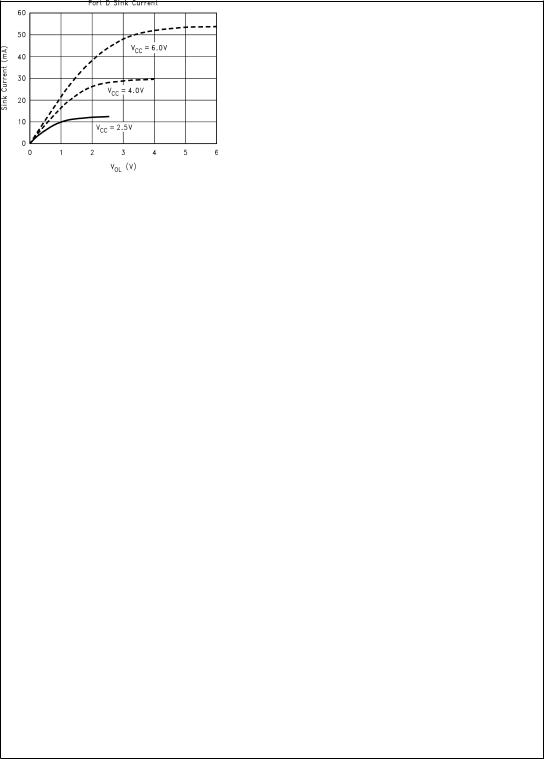
Analog Function Block AC and DC Characteristics
VCC = 5.0V, −40ÊC ≤ TA ≤ +85ÊC
Parameter |
Conditions |
Min |
Typ |
Max |
Units |
|
|
|
|
|
|
Input Offset Voltage |
0.4V < VIN < VCC − 1.5V |
|
±10 |
±25 |
mV |
Input Common Mode Voltage Range |
|
0.4 |
|
VCC − 1.5 |
V |
(Note 10) |
|
|
|
|
|
|
|
|
|
|
|
VCC/2 Reference |
4.5V < VCC < 5.5V |
0.5 VCC − 0.04 |
0.5 V CC |
0.5 VCC + 0.04 |
V |
DC Supply Current for |
VCC = 5.5V |
|
|
250 |
µA |
Comparator (when enabled) |
|
|
|
|
|
|
|
|
|
|
|
|
|
|
|
|
|
DC Supply Current for |
VCC = 5.5V |
|
50 |
80 |
µA |
VCC/2 Reference (when enabled) |
|
|
|
|
|
|
|
|
|
|
|
DC Supply Current for |
VCC = 5.5V |
|
|
200 |
µA |
Constant Current Source (when enabled) |
|
|
|
|
|
|
|
|
|
|
|
|
|
|
|
|
|
Constant Current Source |
4.5V < VCC < 5.5V |
10 |
20 |
40 |
µA |
Current Source Variation over |
4.5V < VCC < 5.5V |
|
|
±2 |
µA |
Common Mode Range |
Temp = Constant |
|
|
|
|
|
|
|
|
|
|
Current Source Enable Time |
|
|
1.5 |
2 |
µs |
|
|
|
|
|
|
Comparator Response Time |
100 mV Overdrive, |
|
|
1 |
µs |
|
100 pF Load |
|
|
|
|
|
|
|
|
|
|
Note 9: While performance characteristics are given at VCC = 5.0V, the analog function block will operate over the entire 2.5V±6.0V VCC range. Accuracy of the VCC/2 reference and the constant current source is not guaranteed beyond the specified limits.
Note 10: The device is capable of operating over a common mode voltage range of 0 to VCC − 1.5V, however increased offset voltage will be observed between 0V and 0.4V.
DS101133-18
FIGURE 3. MICROWIRE/PLUS Timing
Typical Performance Characteristics (−55ÊC ≤ TA = +125ÊC)
DS101133-19 |
DS101133-20 |
7 |
www.national.com |
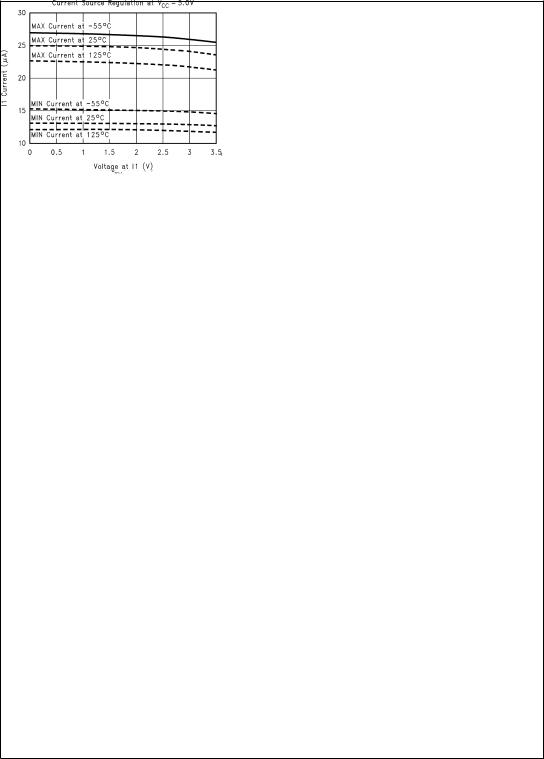
Typical Performance Characteristics (−55ÊC ≤ TA = +125ÊC) (Continued)
DS101133-21 |
DS101133-22 |
DS101133-23 |
DS101133-27 |
DS101133-28 |
DS101133-29 |
www.national.com |
8 |
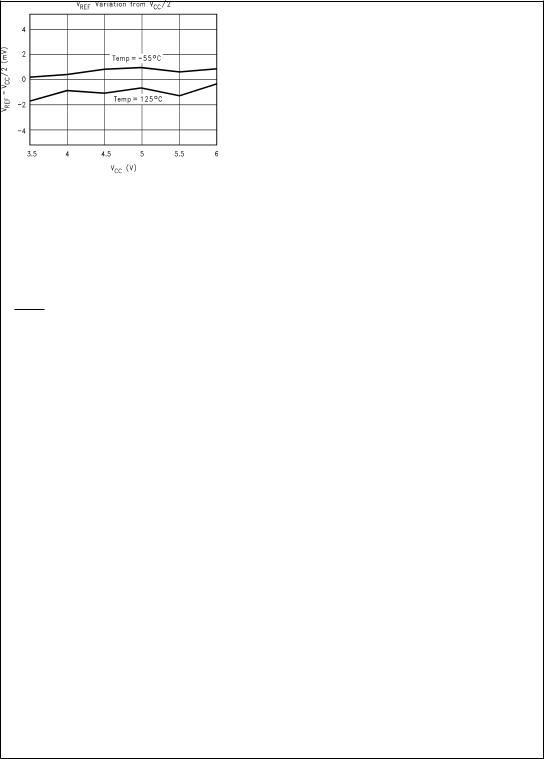
Typical Performance Characteristics (−55ÊC ≤ TA = +125ÊC) (Continued)
Pin Descriptions
VCC and GND are the power supply pins. All VCC and GND pins must be connected.
CKI is the clock input. This can come from an R/C generated oscillator, or a crystal oscillator (in conjunction with CKO). See Oscillator Description section.
RESET is the master reset input. See Reset Description section.
The device contains three bidirectional 8-bit I/O ports (C, G and L), where each individual bit may be independently configured as an input (Schmitt Trigger inputs on ports L and G), output or TRI-STATE under program control. Three data memory address locations are allocated for each of these I/O ports. Each I/O port has two associated 8-bit memory mapped registers, the CONFIGURATION register and the output DATA register. A memory mapped address is also reserved for the input pins of each I/O port. (See the memory map for the various addresses associated with the I/O ports.) Figure 4 shows the I/O port configurations. The DATA and CONFIGURATION registers allow for each port bit to be individually configured under software control as shown below:
CONFIGURA- |
DATA |
Port Set-Up |
TION |
|
|
|
|
|
Register |
Register |
|
|
|
|
0 |
0 |
Hi-Z Input |
|
|
(TRI-STATE Output) |
0 |
1 |
Input with Weak Pull-Up |
1 |
0 |
Push-Pull Zero Output |
1 |
1 |
Push-Pull One Output |
|
|
|
PORT L is an 8-bit I/O port. All L-pins have Schmitt triggers on the inputs.
The Port L supports Multi-Input Wake Up on all eight pins. L4 and L5 are used for the timer input functions T2A and T2B. L6 and L7 are used for the timer input functions T3A and T3B.
DS101133-30
The Port L has the following alternate features:
L7 MIWU or T3B
L6 MIWU or T3A
L5 MIWU or T2B
L4 MIWU or T2A
L3 MIWU
L2 MIWU
L1 MIWU
L0 MIWU
Port G is an 8-bit port with 5 I/O pins (G0, G2±G5), an input pin (G6), and a dedicated output pin (G7). Pins G0 and G2±G6 all have Schmitt Triggers on their inputs. Pin G1 serves as the dedicated WDOUT WATCHDOG output, while pin G7 is either input or output depending on the oscillator mask option selected. With the crystal oscillator option selected, G7 serves as the dedicated output pin for the CKO clock output. With the single-pin R/C oscillator mask option selected, G7 serves as a general purpose input pin but is also used to bring the device out of HALT mode with a low to high transition on G7. There are two registers associated with the G Port, a data register and a configuration register. Therefore, each of the 5 I/O bits (G0, G2±G5) can be individually configured under software control.
Since G6 is an input only pin and G7 is the dedicated CKO clock output pin (crystal clock option) or general purpose input (R/C clock option), the associated bits in the data and configuration registers for G6 and G7 are used for special purpose functions as outlined on the next page. Reading the G6 and G7 data bits will return zeros.
9 |
www.national.com |
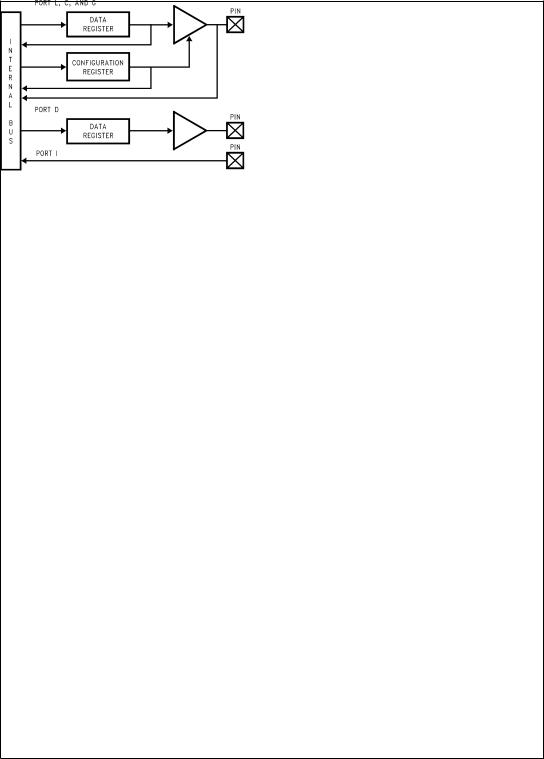
Pin Descriptions (Continued)
DS101133-5
FIGURE 4. I/O Port Configurations
Note that the chip will be placed in the HALT mode by writing a ª1º to bit 7 of the Port G Data Register. Similarly the chip will be placed in the IDLE mode by writing a ª1º to bit 6 of the Port G Data Register.
Writing a ª1º to bit 6 of the Port G Configuration Register enables the MICROWIRE/PLUS to operate with the alternate phase of the SK clock. The G7 configuration bit, if set high, enables the clock start up delay after HALT when the R/C clock configuration is used.
|
Config Reg. |
Data Reg. |
|
|
|
G7 |
CLKDLY |
HALT |
|
|
|
G6 |
Alternate SK |
IDLE |
|
|
|
Port G has the following alternate features:
G6 SI (MICROWIRE Serial Data Input)
G5 SK (MICROWIRE Serial Clock)
G4 SO (MICROWIRE Serial Data Output)
G3 T1A (Timer T1 I/O)
G2 T1B (Timer T1 Capture Input)
G0 INTR (External Interrupt Input)
Port G has the following dedicated functions:
G7 CKO Oscillator dedicated output or general purpose input
G1 WDOUT WATCHDOG and/or Clock Monitor dedicated output
Port C is an 8-bit I/O port. The 40-pin device does not have a full complement of Port C pins. The unavailable pins are not terminated. A read operation for these unterminated pins will return unpredicatable values.
PORT I is an eight-bit Hi-Z input port. The 28-pin device does not have a full complement of Port I pins. The unavailable pins are not terminated i.e., they are floating. A read operation for these unterminated pins will return unpredictable values. The user must ensure that the software takes this into account by either masking or restricting the accesses to bit operations. The unterminated Port I pins will draw power only when addressed.
Port I is an eight-bit Hi-Z input port.
Port I0±I7 are used for the analog function block.
The Port I has the following alternate features:
I7 COMPOUT (Comparator Output)
I6 COMPIN5+ (Comparator Positive Input 5)
I5 COMPIN4+ (Comparator Positive Input 4)
I4 COMPIN3+ (Comparator Positive Input 3)
I3 COMPOUT/COMPIN2+ (Comparator Output/
Comparator Positive Input 2))
I2 COMPIN0+ (Comparator Positive Input 0)
I1 COMPIN− (Comparator Negative Input/Current
Source Out)
I0 COMPIN1+ (Comparator Positive Input 1)
Port D is an 8-bit output port that is preset high when RESET goes low. The user can tie two or more D port outputs (except D2) together in order to get a higher drive.
Note: Care must be exercised with the D2 pin operation. At RESET, the external loads on this pin must ensure that the output voltages stay above 0.8 VCC to prevent the chip from entering special modes. Also keep the external loading on D2 to <1000 pF.
Functional Description
The architecture of the device is modified Harvard architecture. With the Harvard architecture, the control store program memory (ROM) is separated from the data store memory (RAM). Both ROM and RAM have their own separate addressing space with separate address buses. The architecture, though based on Harvard architecture, permits transfer of data from ROM to RAM.
CPU REGISTERS
The CPU can do an 8-bit addition, subtraction, logical or shift operation in one instruction (tc) cycle time.
There are six CPU registers:
A is the 8-bit Accumulator Register
PC is the 15-bit Program Counter Register
PU is the upper 7 bits of the program counter (PC)
PL is the lower 8 bits of the program counter (PC)
B is an 8-bit RAM address pointer, which can be optionally post auto incremented or decremented.
X is an 8-bit alternate RAM address pointer, which can be optionally post auto incremented or decremented.
SP is the 8-bit stack pointer, which points to the subroutine/ interrupt stack (in RAM). The SP is initialized to RAM address 06F with reset.
www.national.com |
10 |

Functional Description (Continued)
S is the 8-bit Data Segment Address Register used to extend the lower half of the address range (00 to 7F) into 256 data segments of 128 bytes each.
All the CPU registers are memory mapped with the exception of the Accumulator (A) and the Program Counter (PC).
The device can be configured to inhibit external reads of the program memory. This is done by programming the Security Byte.
PROGRAM MEMORY
The program memory consists of 8192 bytes of OTP EPROM. These bytes may hold program instructions or constant data (data tables for the LAID instruction, jump vectors for the JID instruction, and interrupt vectors for the VIS instruction). The program memory is addressed by the 15-bit program counter (PC). All interrupts in the devices vector to program memory location 0FF Hex.
The device can be configured to inhibit external reads of the program memory. This is done by programming the Security Byte.
SECURITY FEATURE
The program memory array has an associate Security Byte that is located outside of the program address range. This byte can be addressed only from programming mode by a programmer tool.
Security is an optional feature and can only be asserted after the memory array has been programmed and verified. A secured part will read all 00(hex) by a programmer. The part will fail Blank Check and will fail Verify operations. A Read operation will fill the programmer's memory with 00(hex). The Security Byte itself is always readable with value of 00(hex) if unsecure and FF(hex) if secure.
DATA MEMORY
The data memory address space includes the on-chip RAM and data registers, the I/O registers (Configuration, Data and Pin), the control registers, the MICROWIRE/PLUS SIO shift register, and the various registers, and counters associated with the timers (with the exception of the IDLE timer). Data memory is addressed directly by the instruction or indirectly by the B, X, SP pointers and S register.
The data memory consists of 256 bytes of RAM. Sixteen bytes of RAM are mapped as ªregistersº at addresses 0F0 to 0FF Hex. These registers can be loaded immediately, and also decremented and tested with the DRSZ (decrement register and skip if zero) instruction. The memory pointer registers X, SP, B and S are memory mapped into this space at address locations 0FC to 0FF Hex respectively, with the other registers being available for general usage.
The instruction set permits any bit in memory to be set, reset or tested. All I/O and registers (except A and PC) are memory mapped; therefore, I/O bits and register bits can be directly and individually set, reset and tested. The accumulator (A) bits can also be directly and individually tested.
Note: RAM contents are undefined upon power-up.
Data Memory Segment RAM
Extension
Data memory address 0FF is used as a memory mapped location for the Data Segment Address Register (S).
The data store memory is either addressed directly by a single byte address within the instruction, or indirectly relative to the reference of the B, X, or SP pointers (each contains a single-byte address). This single-byte address allows an addressing range of 256 locations from 00 to FF hex. The upper bit of this single-byte address divides the data store memory into two separate sections as outlined previously. With the exception of the RAM register memory from address locations 00F0 to 00FF, all RAM memory is memory mapped with the upper bit of the single-byte address being equal to zero. This allows the upper bit of the single-byte address to determine whether or not the base address range (from 0000 to 00FF) is extended. If this upper bit equals one (representing address range 0080 to 00FF), then address extension does not take place. Alternatively, if this upper bit equals zero, then the data segment extension register S is used to extend the base address range (from 0000 to 007F) from XX00 to XX7F, where XX represents the 8 bits from the S register. Thus the 128-byte data segment extensions are located from addresses 0100 to 017F for data segment 1, 0200 to 027F for data segment 2, etc., up to FF00 to FF7F for data segment 255. The base address range from 0000 to 007F represents data segment 0.
Figure 5 illustrates how the S register data memory extension is used in extending the lower half of the base address range (00 to 7F hex) into 256 data segments of 128 bytes each, with a total addressing range of 32 kbytes from XX00 to XX7F. This organization allows a total of 256 data segments of 128 bytes each with an additional upper base segment of 128 bytes. Furthermore, all addressing modes are available for all data segments. The S register must be changed under program control to move from one data segment (128 bytes) to another. However, the upper base segment (containing the 16 memory registers, I/O registers, control registers, etc.) is always available regardless of the contents of the S register, since the upper base segment (address range 0080 to 00FF) is independent of data segment extension.
The instructions that utilize the stack pointer (SP) always reference the stack as part of the base segment (Segment 0), regardless of the contents of the S register. The S register is not changed by these instructions. Consequently, the stack (used with subroutine linkage and interrupts) is always located in the base segment. The stack pointer will be intitialized to point at data memory location 006F as a result of reset.
The 128 bytes of RAM contained in the base segment are split between the lower and upper base segments. The first 112 bytes of RAM are resident from address 0000 to 006F in the lower base segment, while the remaining 16 bytes of RAM represent the 16 data memory registers located at addresses 00F0 to 00FF of the upper base segment. No RAM is located at the upper sixteen addresses (0070 to 007F) of the lower base segment.
Additional RAM beyond these initial 128 bytes, however, will always be memory mapped in groups of 128 bytes (or less) at the data segment address extensions (XX00 to XX7F) of the lower base segment. The additional 128 bytes of RAM are memory mapped at address locations 0100 to 017F hex.
11 |
www.national.com |

Data Memory Segment RAM
Extension (Continued)
DS101133-6
*Reads as all ones.
FIGURE 5. RAM Organization
Reset
The RESET input when pulled low initializes the microcontroller. Initialization will occur whenever the RESET input is pulled low. Upon initialization, the data and configuration registers for ports L, G and C are cleared, resulting in these Ports being initialized to the TRI-STATE mode. Pin G1 of the G Port is an exception (as noted below) since pin G1 is dedicated as the WATCHDOG and/or Clock Monitor error output pin. Port D is set high. The PC, PSW, ICNTRL, CNTRL, T2CNTRL and T3CNTRL control registers are cleared. The Comparator Select Register is cleared. The S register is initialized to zero. The Multi-Input Wakeup registers WKEN and WKEDG are cleared. Wakeup register WKPND is unknown. The stack pointer, SP, is initialized to 6F hex.
The device comes out of reset with both the WATCHDOG logic and the Clock Monitor detector armed, with the WATCHDOG service window bits set and the Clock Monitor bit set. The WATCHDOG and Clock Monitor circuits are inhibited during reset. The WATCHDOG service window bits being initialized high default to the maximum WATCHDOG service window of 64k tC clock cycles. The Clock Monitor bit being initialized high will cause a Clock Monitor error following reset if the clock has not reached the minimum specified frequency at the termination of reset. A Clock Monitor error will cause an active low error output on pin G1. This error output will continue until 16 tC±32 tC clock cycles following the clock frequency reaching the minimum specified value, at which time the G1 output will enter the TRI-STATE mode.
The external RC network shown in Figure 6 should be used to ensure that the RESET pin is held low until the power supply to the chip stabilizes.
DS101133-7
RC > 5 x Power Supply Rise Time
FIGURE 6. Recommended Reset Circuit
Oscillator Circuits
The chip can be driven by a clock input on the CKI input pin which can be between DC and 10 MHz. The CKO output clock is on pin G7 (crystal configuration). The CKI input frequency is divided down by 10 to produce the instruction cycle clock (1/tc).
Note: External clocks with frequencies above about 4 MHz require the user to drive the CKO (G7) pin with a signal 180 degrees out of phase with CKI.
Figure 7 shows the Crystal and R/C oscillator diagrams.
CRYSTAL OSCILLATOR
CKI and CKO can be connected to make a closed loop crystal (or resonator) controlled oscillator.
Table 1 shows the component values required for various standard crystal values.
R/C OSCILLATOR
By selecting CKI as a single pin oscillator input, a single pin R/C oscillator circuit can be connected to it. CKO is available as a general purpose input, and/or HALT restart input.
Note: Use of the R/C oscillator option will result in higher electromagnetic emissions.
Table 2 shows the variation in the oscillator frequencies as functions of the component (R and C) values.
DS101133-8
DS101133-9
FIGURE 7. Crystal and R/C Oscillator Diagrams
www.national.com |
12 |

Oscillator Circuits (Continued)
TABLE 1. Crystal Oscillator Configuration, TA = 25ÊC
R1 |
R2 |
C1 |
C2 |
|
|
CKI Freq |
|
Conditions |
||||||
(kΩ) |
(MΩ) |
(pF) |
(pF) |
|
|
|
(MHz) |
|
||||||
|
|
|
|
|
|
|
||||||||
0 |
1 |
|
30 |
|
30±36 |
|
10 |
|
|
VCC = 5V |
||||
0 |
1 |
|
30 |
|
30±36 |
|
4 |
|
|
VCC = 5V |
||||
0 |
1 |
|
200 |
|
100±150 |
|
0.455 |
|
|
VCC = 5V |
||||
TABLE 2. RC Oscillator Configuration, TA = 25ÊC |
||||||||||||||
|
|
|
|
|
|
|
|
|
|
|
|
|||
R |
C |
CKI Freq |
Instr. Cycle |
|
Conditions |
|||||||||
(kΩ) |
(pF) |
(MHz) |
|
|
(µs) |
|
||||||||
|
|
|
|
|
|
|||||||||
|
|
|
|
|
|
|
|
|
|
|
|
|
||
3.3 |
82 |
|
2.2 to 2.7 |
|
3.7 to 4.6 |
|
VCC = 5V |
|||||||
5.6 |
100 |
|
1.1 to 1.3 |
|
7.4 to 9.0 |
|
VCC = 5V |
|||||||
6.8 |
100 |
|
0.9 to 1.1 |
|
8.8 to 10.8 |
|
VCC = 5V |
|||||||
Note 11: 3k ≤ R ≤ 200k |
|
|
|
|
|
|
|
|
|
|
||||
50 pF ≤ C ≤ 200 pF |
|
|
|
|
|
|
|
|
|
|
||||
Control Registers |
|
|
|
|
|
|
|
|
|
|||||
CNTRL Register (Address X©00EE) |
|
|
|
|
||||||||||
|
|
|
|
|
|
|
|
|
|
|
|
|||
T1C3 |
T1C2 |
|
T1C1 |
|
T1C0 |
MSEL |
IEDG |
|
SL1 |
SL0 |
|
|||
|
|
|
|
|
|
|
|
|
|
|
|
|
|
|
Bit 7 |
|
|
|
|
|
|
|
|
|
|
|
|
Bit 0 |
|
|
|
|
|
|
|
|
|
|
|
|
|
|
|
|
The Timer1 (T1) and MICROWIRE/PLUS control register contains the following bits:
T1C3 |
Timer T1 mode control bit |
T1C2 |
Timer T1 mode control bit |
T1C1 |
Timer T1 mode control bit |
T1C0 |
Timer T1 Start/Stop control in timer |
|
modes 1 and 2, T1 Underflow Interrupt |
|
Pending Flag in timer mode 3 |
MSEL |
Selects G5 and G4 as MICROWIRE/PLUS |
|
signals SK and SO respectively |
IEDG |
External interrupt edge polarity select |
|
(0 = Rising edge, 1 = Falling edge) |
SL1 & SL0 |
Select the MICROWIRE/PLUS clock divide |
|
by (00 = 2, 01 = 4, 1x = 8) |
PSW Register (Address X©00EF)
HC |
C |
T1PNDA |
T1ENA |
EXPND |
BUSY |
EXEN |
GIE |
|
|
|
|
|
|
|
|
Bit 7 |
|
|
|
|
|
|
Bit 0 |
|
|
|
|
|
|
|
|
The PSW register contains the following select bits:
HC |
Half Carry Flag |
C |
Carry Flag |
T1PNDA Timer T1 Interrupt Pending Flag (Autoreload RA in mode 1, T1 Underflow in Mode 2, T1A capture edge in mode 3)
T1ENA |
Timer T1 Interrupt Enable for Timer Underflow |
|
or T1A Input capture edge |
EXPND |
External interrupt pending |
BUSY |
MICROWIRE/PLUS busy shifting flag |
EXEN |
Enable external interrupt |
GIE |
Global interrupt enable (enables interrupts) |
The Half-Carry flag is also affected by all the instructions that affect the Carry flag. The SC (Set Carry) and R/C (Reset Carry) instructions will respectively set or clear both the carry
flags. In addition to the SC and R/C instructions, ADC, SUBC, RRC and RLC instructions affect the Carry and Half Carry flags.
ICNTRL Register (Address X©00E8)
Rsvd |
|
LPEN |
T0PND |
T0EN |
µWPND |
|
µWEN |
T1PNDB |
T1ENB |
||||||
|
|
|
|
|
|
|
|
|
|
|
|
|
|
|
|
Bit 7 |
|
|
|
|
|
|
|
|
|
|
|
|
|
Bit 0 |
|
|
|
|
|
|
|
|
|
|
|
|
|
|
|
||
The ICNTRL register contains the following bits: |
|
||||||||||||||
Rsvd |
|
|
This bit is reserved and must be zero |
|
|||||||||||
LPEN |
L Port Interrupt Enable (Multi-Input Wakeup/ |
||||||||||||||
|
|
|
|
Interrupt) |
|
|
|
|
|
||||||
T0PND |
Timer T0 Interrupt pending |
|
|
||||||||||||
T0EN |
Timer T0 Interrupt Enable (Bit 12 toggle) |
||||||||||||||
µWPND |
MICROWIRE/PLUS interrupt pending |
|
|||||||||||||
µWEN |
Enable MICROWIRE/PLUS interrupt |
|
|||||||||||||
T1PNDB |
Timer T1 Interrupt Pending Flag for T1B cap- |
||||||||||||||
|
|
|
|
ture edge |
|
|
|
|
|
||||||
T1ENB |
Timer T1 Interrupt Enable for T1B Input capture |
||||||||||||||
|
|
|
|
edge |
|
|
|
|
|
||||||
T2CNTRL Register (Address X©00C6) |
|
|
|||||||||||||
|
|
|
|
|
|
|
|
|
|
|
|||||
T2C3 |
|
T2C2 |
T2C1 |
T2C0 |
T2PNDA |
|
T2ENA |
|
T2PNDB |
T2ENB |
|||||
|
|
|
|
|
|
|
|
|
|
|
|
|
|
|
|
Bit 7 |
|
|
|
|
|
|
|
|
|
|
|
|
|
Bit 0 |
|
|
|
|
|
|
|
|
|
|
|
|
|
|
|
|
|
The T2CNTRL control register contains the following bits:
T2C3 Timer T2 mode control bit
T2C2 Timer T2 mode control bit
T2C1 Timer T2 mode control bit
T2C0 |
Timer |
T2 |
Start/Stop control in |
timer |
|||
|
|
modes 1 and 2, T2 Underflow Interrupt Pend- |
|||||
|
|
ing Flag in timer mode 3 |
|
||||
T2PNDA |
Timer T2 Interrupt Pending Flag (Autoreload |
||||||
|
|
RA in mode 1, T2 Underflow in mode 2, T2A |
|||||
|
|
capture edge in mode 3) |
|
||||
T2ENA |
Timer T2 Interrupt Enable for Timer Underflow |
||||||
|
|
or T2A Input capture edge |
|
||||
T2PNDB |
Timer T2 Interrupt Pending Flag for T2B cap- |
||||||
|
|
ture edge |
|
|
|
|
|
T2ENB |
Timer T2 Interrupt Enable for Timer Underflow |
||||||
|
|
or T2B Input capture edge |
|
||||
T3CNTRL Register (Address X©00B6) |
|
||||||
|
|
|
|
|
|
|
|
T3C3 |
T3C2 |
T3C1 |
T3C0 |
T3PNDA |
T3ENA |
T3PNDB |
T3ENB |
|
|
|
|
|
|
|
|
Bit 7 |
|
|
|
|
|
Bit 0 |
|
|
|
|
|
|
|
|
|
The T3CNTRL control register contains the following bits:
T3C3 |
Timer T3 mode control bit |
T3C2 |
Timer T3 mode control bit |
T3C1 |
Timer T3 mode control bit |
T3C0 |
Timer T3 Start/Stop control in timer |
|
modes 1 and 2, T3 Underflow Interrupt Pend- |
|
ing Flag in timer mode 3 |
T3PNDA |
Timer T3 Interrupt Pending Flag (Autoreload |
|
RA in mode 1, T3 Underflow in mode 2, T3A |
|
capture edge in mode 3) |
T3ENA |
Timer T3 Interrupt Enable for Timer Underflow |
|
or T3A Input capture edge |
T3PNDB |
Timer T3 Interrupt Pending Flag for T3B cap- |
|
ture edge |
T3ENB |
Timer T3 Interrupt Enable for Timer Underflow |
|
or T3B Input capture edge |
13 |
www.national.com |
